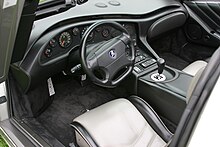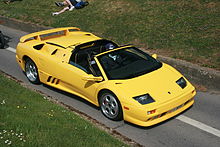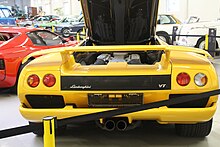Lamborghini Diablo
| Lamborghini | |
|---|---|
|
Diablo SV (UK version)
|
|
| Diablo | |
| Production period: | 1990-2001 |
| Class : | Sports car |
| Body versions : | Coupé , roadster |
| Engines: |
Gasoline engines : 5.7–6.0 liters (331–434 kW) |
| Length: | 4460 mm |
| Width: | 2040 mm |
| Height: | 1100 mm |
| Wheelbase : | 2650 mm |
| Empty weight : | 1460-1695 kg |
| Previous model | Lamborghini Countach |
| successor | Lamborghini Murciélago |
The Lamborghini Diablo ( Spanish : devil ) is a Lamborghini sports car that was built between 1990 and 2001. It is the direct successor model of the Lamborghini Countach and has been replaced by the Lamborghini Murciélago .
History of origin
The planning for the P132 project, from which the Diablo emerged, began in 1985. The goal was not only to find a successor to the Countach , but also to build the fastest production vehicle in the world. So the car had to go at least 320 km / h, even if no buyer could ever drive it out. A test vehicle is said to have reached 337 km / h on the Nardò route , and the specified maximum speed of 325 km / h was also exceeded in independent tests.
The P132 is bigger, heavier and much more powerful than the Countach. It differs significantly in technical terms, but uses the same transmission upstream of the engine and the further developed V12 from the Countach. Marcello Gandini had to design several body shapes at once before one of them was approved by Chrysler's management . The tubular frame differs from that of the Countach in that it has a longer wheelbase and the use of square instead of round tubes. The body is the combination of steel, light metal, carbon fiber reinforced plastic and other expensive materials expected at the time .
The V12 has a displacement of 5707 cm³ instead of the 5167 cm³ of the Countach. Bore and stroke were increased so that both engine power and torque increased. For the first time, all versions of this engine were equipped with an in-house manifold injection system, regardless of the country in which they were sold.
The shape of the car is typical of the work of the vehicle designer Gandini; Other cars designed by him from this period confirm this. Special features are long, flowing lines with large air inlets in the sides and shortened front fenders, which are followed by low, flat side windows. The C w value is 0.31, which is significantly lower than that of the Countach.
The interior was not designed by Gandini. It came from Chrysler in Detroit, an arrangement with two seats, curvy lines and a wide center console.
Diablo and Diablo VT
When it was presented in 1990, the Diablo was initially only offered with rear-wheel drive . In 1993 the all-wheel drive Diablo VT (for Visco Traction ) came on the market. 1995 the Diablo VT Roadster was presented in December at the Bologna Motor Show . They all had the 5.7 liter V12 with 362 kW (492 hp). The VT and VT Roadster were built unchanged until 1999; the basic rear-wheel drive model was discontinued in 1998.
Diablo SE 30
From 1993 to 1995 the Special Edition SE 30 was built to celebrate Lamborghini's 30th birthday. Its V12 engine now developed 386 kW (525 hp). In addition to improved equipment and a rear wing , the special model could be recognized by a small sticker on the rear. Only 150 pieces were built.
In 1995 Lamborghini also offered the Jota package for the SE . Owners of the Special Edition could bring their vehicle to Lamborghini for conversion. It contained two air inlets on the roof, a reinforced transmission and various measures to save weight through lighter materials. In addition, the brakes have been adapted to the increased engine power. The increase in performance to 438 kW (596 PS) was achieved through improved engine electronics, a higher speed limit and a special racing exhaust system. It is estimated that around 12 to 15 vehicles were converted. A total of 28 Jota kits were built. With these modifications, the cars were not roadworthy , mainly because of the extreme exhaust system .
Based on the VT , three Diablo VT-R were built in 1996 in the colors yellow, red and orange. These vehicles have parts of the SE body kit including the large rear wing. The wheels and retractable side windows came from the normal VT. It is not known whether these special models are equipped with the normal series engine, some sources also speak of a twelve-cylinder tuned to over 400 kW (544 hp).
Diablo SV
In 1995 Lamborghini presented the Diablo SV with a more powerful V12 and 375 kW (510 PS). It lacks the all-wheel drive and the electronic chassis of the VT , but it has the more powerful braking system and revised interior. A new three-part adjustable rear wing provides more contact pressure. A roadster version of the SV was also presented at the Geneva Motor Show in March 1998. Only five were produced, as the new owner Audi relied on all-wheel drive for all Lamborghinis. Interestingly, almost all roadsters already have the 390 kW (530 hp) engine and other specifications of the subsequent model upgrade.
Racing models
Lamborghini presented the SV-R as a racing car for its own Diablo brand cup in 1996 in Geneva . On the basis of the SV, these vehicles were equipped for racing. Everything that was not absolutely necessary was removed from these racing cars. In addition to larger spoilers, they also got a modified chassis , a more stable braking system and special Sparco seats. About 30 vehicles were built, including a roadster called the Diablo Roadster-R in 1997 . A larger production was also planned by him, but remained with one model. The engine output for the Roadster and Coupe is around 400 kW (544 hp). Some SV-R were later even converted to be roadworthy.
Facelift 1999
In 1999 a major facelift took place, the most striking feature of which was the replacement of the pop-up headlights with fixed headlights. These came from the Nissan 300ZX , with the Nissan lettering on the upper edge being covered by a black panel. The Diablo has also been updated in the interior. In addition, a new ABS brake system was introduced and the chassis was modified in order to bring the increased output (e.g. through variable valve control) of 390 kW (530 PS) onto the road. The Diablo SV with rear-wheel drive and the all-wheel drive variants VT and VT Roadster were available .
Two special models based on the VT and VT Roadster were only available in the USA . The Alpine Edition (twelve coupes produced) has a special interior with carbon inlays and an Alpine navigation and sound system. The Diablo VT Roadster Momo Edition with a yellow-red interior and some Momo accessories was also produced in twelve copies .
At the turn of the millennium, Lamborghini brought out the Diablo Roadster Millennium . The version, limited to 30 pieces, has an extensive two-tone leather interior and various carbon attachments. This was the last open Diablo, after that there were only closed variants until 2001.
Diablo GT and GT-R
Shortly before that, in September 1999, the Diablo GT came on the market, which had a new six-liter machine on board. When it was first introduced, it was the fastest production sports car in the world with a top speed of 338 km / h, especially since faster cars like the Bugatti EB110 or the McLaren F1 were no longer in production at the time. The heavily revised V12 develops 423 kW (575 hp) here. New, larger brakes and a further modernized interior are also part of the equipment. The weight was also reduced through lightweight construction. 80 pieces were built.
The even more extreme Diablo GT-R, presented in December 1999, offers even more power, namely 438 kW (596 PS) . It was intended for the 2000 Lamborghini Diablo Supertrophy season. Only 30 units were planned. In the end around 40 were produced.
Last facelift
A year later, the six-liter V12 from the GT found space in a somewhat tamer version in the new Diablo VT 6.0 . This was the last evolutionary stage of the Diablo. The interior was revised again and it was given a modified look (including the front and rear sections). A rear spoiler was available as an option here.
At the end of production in 2001 there was still the Diablo VT 6.0 SE special model . 44 pieces were produced with similar equipment as in the Roadster Millennium (noble leather interior and carbon applications). The SE was available in two liveries: Oro Elios (Gold) and Marrone Eklipsis (Brown). In addition, a part Alpine - navigation system in the delivery.
The successor model Murciélago appeared in 2001.
Engines and production numbers
The Diablo was equipped with different variants of a V12 engine . Only the rear axle is driven in the basic model and in most sport versions such as the SV, GT and GTR . The models marked with VT have all-wheel drive .
| model | construction time | Displacement | power | Max. Torque | number of pieces |
|---|---|---|---|---|---|
| Diablo | 1990 to 1998 | 5707 cc | 362 kW (492 hp) at 7000 min -1 |
580 Nm at 5200 min -1 |
873 pieces |
| Diablo Roadster | 1996 to 1998 | 5707 cc | 362 kW (492 hp) at 7000 min -1 |
580 Nm at 5200 min -1 |
less than 100 pieces |
| Diablo Roadster R | 1997 | 5707 cc | 395 kW (537 hp) at 7100 min -1 |
580 Nm at 5200 min -1 |
1 piece |
| Diablo VT | 1993 to 1999 | 5707 cc | 362 kW (492 hp) at 7000 min -1 |
580 Nm at 5200 min -1 |
approx. 400 pieces |
| Diablo SE 30 | 1993 to 1995 | 5707 cc | 386 kW (525 hp) at 7000 min -1 |
590 Nm at 5500 min -1 |
150 pieces (including around 15-28 JOTA conversions) |
| Diablo SE 30 with Jota specification | 1995 to 1996 | 5707 cc | 438 kW (596 hp) at 7300 min -1 |
640 Nm at 4800 min -1 |
approx. 15–28 pieces |
| Diablo SV | 1995 to 1999 | 5707 cc | 375 kW (510 hp) at 7100 min -1 |
580 Nm at 5200 min -1 |
approx. 120 pieces |
| Diablo VT Roadster | 1995 to 1999 | 5707 cc | 362 kW (492 hp) at 7000 min -1 |
580 Nm at 5200 min -1 |
466 pieces |
| Diablo SV | 1999 to 2000 | 5707 cc | 390 kW (530 hp) at 7000 min -1 |
590 Nm at 5500 min -1 |
approx. 100 pieces |
| Diablo SV-R | 1996 to 1999 | 5707 cc | 395 kW (537 hp) at 7100 min -1 |
580 Nm at 5200 min -1 |
--- piece |
| Diablo VT | 1999 to 2000 | 5707 cc | 390 kW (530 hp) at 7000 min -1 |
590 Nm at 5500 min -1 |
--- piece |
| Diablo VT-R | 1995 to 2000 | 5707 cc | 362 kW (492 hp) at 7000 min -1 |
580 Nm at 5200 min -1 |
--- piece |
| Diablo VT Roadster | 1999 to 2000 | 5707 cc | 390 kW (530 hp) at 7000 min -1 |
590 Nm at 5500 min -1 |
approx. 100 pieces |
| Diablo GT | 1999 to 2000 | 5992 cc | 423 kW (575 hp) at 7300 min -1 |
630 Nm at 5500 min -1 |
83 pieces |
| Diablo GT1 | 1997 to 2000 | 5992 cc | 480 kW (653 hp) at 7500 min -1 |
--- Nm at ---- min −1 |
1 piece |
| Diablo GT2 | 1998 | 5992 cc | 471 kW (640 hp) at 7500 min -1 |
--- Nm at ---- min −1 |
1 piece |
| Diablo VT 6.0 | 2000 to 2001 | 5992 cc | 404 kW (549 hp) at 7100 min -1 |
620 Nm at 5500 min -1 |
260 pieces |
| Diablo VT 6.0 SE (Special Edition) | 2001 | 5992 cc | 404 kW (549 hp) at 7100 min -1 |
620 Nm at 5500 min -1 |
44 pieces |
| Diablo GT-R | 2000 | 5992 cc | 434 kW (590 hp) at 7300 min -1 |
640 Nm at 5500 min -1 |
approx. 30-40 pieces |
| Diablo prototype | 1986 | 5300 cc | 478 kW (650 hp) at ---- min -1 |
--- Nm at ---- min −1 |
1 piece |
| total | 2903 pieces |
Driving performance and weight of the individual models
| model | Top speed | Acceleration from 0 to 100 km / h | Empty weight |
|---|---|---|---|
| Diablo | 325 km / h | 4.1 s | 1575 kg |
| Diablo Roadster | 328 km / h | 4.1 s | 1625 kg |
| Diablo SV | 333 km / h | 3.9 s | 1600 kg |
| Diablo Roadster SV | 323 km / h | 3.9 s | 1530 kg |
| Diablo VT | 328 km / h | 4.1 s | 1625 kg |
| Diablo SE 30 | 333 km / h | 4.0 s | 1450 kg |
| Diablo SE 30 iota | 340 km / h | 3.7 s | 1450 kg |
| Diablo VT Roadster | 335 km / h | 4.0 s | 1695 kg |
| Diablo GT | 338 km / h | 3.9 s | 1460 kg |
| Diablo VT 6.0 | 330 km / h | 3.9 s | 1625 kg |
| Diablo GTR | 345 km / h | 3.5 s | 1395 kg |
| Diablo VTR | 328 km / h | 4.1 s | 1625 kg |
| Diablo SVR | 330 km / h | 3.7 s | 1385 kg |
| Diablo 6.0 | 330 km / h | 4.0 s | 1625 kg |
| Diablo 6.0 SE | 330 km / h | 4.0 s | 1625 kg |
| Diablo Roadster R | 330 km / h | - s | 1430 kg |
Special models
Lamborghini Alar 777
The Lamborghini importer and designer Jorge Antonio Fernández García, who lives in Argentina under the stage name Joan Ferci, builds special models of the Diablo with the official approval of Lamborghini. After the Coatl and the Eros GT-1 , Ferci presented the Alar 777 in Buenos Aires in 2007 . The nominal output of the V12 engine installed in the Diablo has been increased to 700 hp for this model.
Lamborghini Canto
In 1997 the then managing director of Lamborghini, Vittorio Di Capua, planned a successor to the aging Diablo, the Canto. Sales would have started in 1999, but on May 7, 1998, a group of high-ranking Audi and VW employees visited Sant'Agata on the occasion of the 35th birthday of Automobili Lamborghini SpA. Ferdinand Piëch did not like the Canto presented at the time, Lamborghini also called L 147 internally, and therefore Lamborghini was not allowed to build the car. In return, Lamborghini received financial support of 155 million euros for the five following years. This money was not only used to develop the Lamborghini Murciélago , but also to finance the museum, the development center and a large showroom.
literature
- Anthony Pritchard: Lamborghini . Heel Verlag, Königswinter 2006. ISBN 3-89880-574-3
Web links
- Pictures of the Lamborghini Alar 777
- Information on all Diablo models at Lambocars.com (English)
- Information on all Diablo models at Lamborghiniregistry.com (English)
Individual evidence
- ↑ http://media.caranddriver.com/files/judgement-day-f40-meets-diablojudgement-day-comparo-full-story.pdf
- ↑ https://www.classicdriver.com/en/article/lamborghini-diablo-vt-roadster-devil-goes-strada
- ↑ Lamborghini Diablo technical data . In: auto motor und sport . ( auto-motor-und-sport.de [accessed on April 10, 2018]).
- ^ The International Lamborghini Registry. Retrieved April 10, 2018 .










